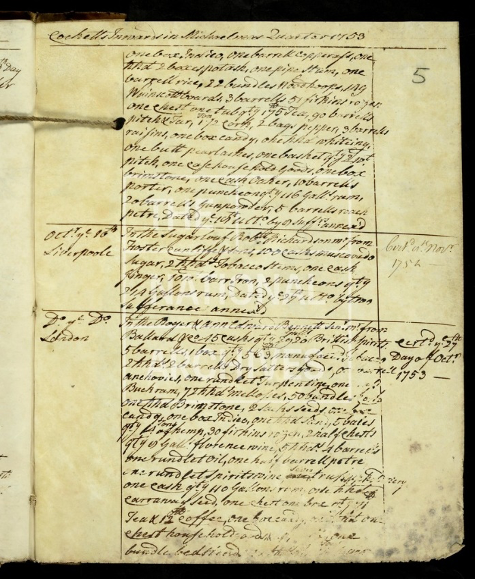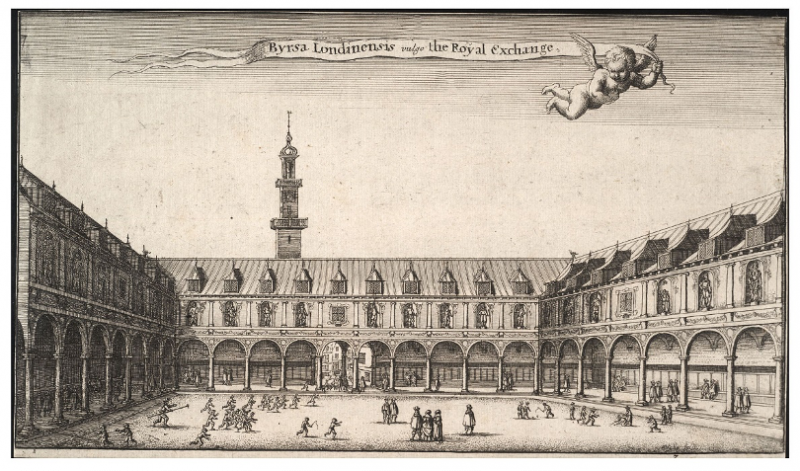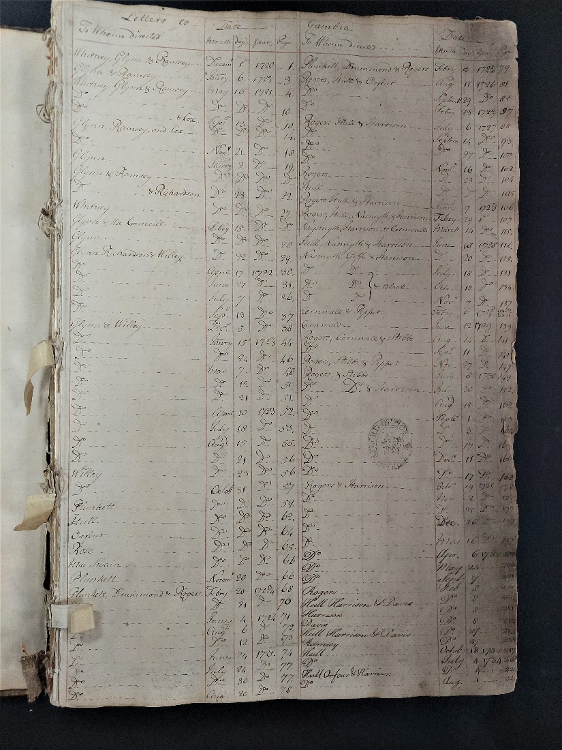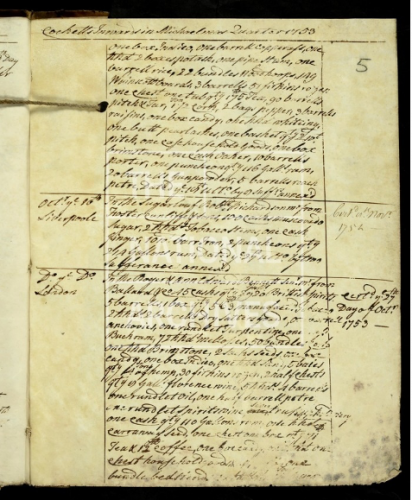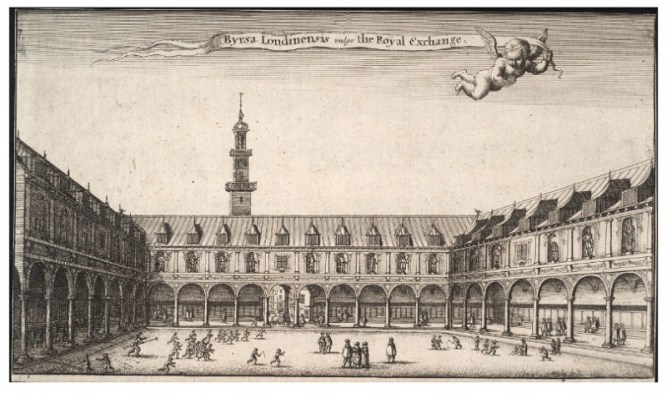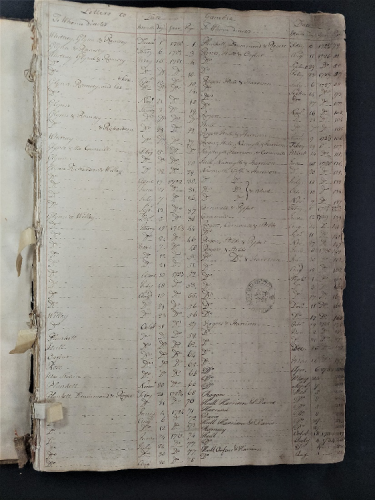Abstract
Beyond the shared activity of trading, merchants belonged to a broad occupational category, which was also reflected in wide-ranging educational backgrounds. The merchant straddled traditional social classes and the rise of the merchant was part of the expansion of the ‘middling sorts’. Cultures of commerce and politeness – two key attributes of eighteenth-century British identity – came together in the figure of the merchant. Sociability was an important element of mercantile culture, because a good reputation and good social networks were integral to a merchant’s credit and financial dealings.
A merchant was ‘a trader or a dealer by wholesale’, especially ‘one who trafficks to remote countries’.1 Not only did the variety of goods they traded vary, but their social background did too. Merchant life could be highly mobile with many merchants moving between town and country and towards London or other port cities like Exeter, Bristol and Newcastle. There was also a sizable number of foreign merchants in eighteenth-century Britain, mainly Huguenots, following the second migrations in the 1680s, but a wide variety of Dutch, German and Swiss merchants too. Mercantile business was largely shaped by social connections and therefore impacted by shared social spaces; Jewish merchants, for instance, congregated in Aldgate nearby London’s oldest synagogue, Bevis Marks.2 The life of the merchant required sustained engagement with the many different modes of sociability that were embedded in everyday urban life.
In London, between them, merchants owned the biggest accumulation of wealth and were among some of the city’s richest men. However, there was a huge divergence between the richest merchants and the average. A career as a merchant was an attractive one, not least because you did not necessarily have to start with large capital, but a young aspirant often needed parents who could pay for their son’s apprenticeship to ensure he got the right training and contracts. The rise of merchants is also associated with the widening of the middling section of society. Somewhere between the gentry and aristocracy and the laboring sorts were the ‘middling sorts’, those who worked but ideally did not get their hands dirty. They typically included professionals such as lawyers and physicians, and merchants, but included a wide range of tradesmen and shopkeepers too. Peter Earle suggests that most middling people were men with fortunes between £500 and £5000.3 Sometimes, however, the income of merchants could match or supersede that of gentlemen.
The distinction between gentlemen and merchant was a fluid one. Social mobility worked both ways and saw gentlemen move into business and merchants move into gentry through land acquisition. In his novel Moll Flanders, Daniel Defoe talked of the hybrid figure of the gentleman-tradesman. Moll, who had hidden her own humble background, sought to marry a London draper who acted like part of the landed gentry.
- 3. Peter Earle, The Making of the English middle class: Business, Society, and Family Life in London, 1660-1730 (Berkeley: University of California Press, 1989), p. 15.
I was not averse to a tradesman, but I would have a tradesman, forsooth, that was something of a gentleman too; that when my husband had a mind to carry me to the court, or to the play, he might become a sword, and look as like a gentleman as another man; and not be one that had the mark of his apron-strings upon his coat, or the mark of his hat upon his periwig […]. Well, at last I found this amphibious creature, this land-water thing called a gentleman tradesman.4
- 4. Daniel Defoe, Moll Flanders, ed. G.A. Starr and Linda Bree (Oxford: Oxford University Press, 2011), p. 51.
Historians debate whether merchants sought to emulate the behaviour of the gentry. There was a spectrum of the middling sort, but the criteria for this category should not just simply relate to income, but to shared values concerning property, industry, improvement, leisure or fashion. Historians have therefore presented two different versions of the middling sort, those who emulated the gentry and aspired for gentlemanly status and those who were independent and industrious and shared moral and social values that differed from the gentry. Margaret Hunt argues that while the emulation of the gentry was a real phenomenon, it was not universal, and therefore both versions of the middling sort must be incorporated into our understanding of this social group.5
Merchants were active participants in what historians have called ‘polite and commercial society’.6 In The Present State of Great Britain (1716), it was declared that: ‘next to the purity of religion we are the most considerable of any nation in the world for the vastness and extensiveness of our trade’.7 Contemporaries saw commerce as the foundation of British greatness, driving the state’s power and wealth. This culture of commerce crossed party divisions and social boundaries, and became an essential part of British identity.8
In the last four decades of the seventeenth century, Britain experienced a revolution in trade. Woollen cloth still dominated the export market, but there were dramatic developments in England’s re-export trade. New world commodities such as sugar and tobacco were exported into Britain and then re-exported to continental Europe. By the eighteenth century, the re-export trade was worth almost a third of the total exports. The destination of exports, including re-exports, also changed throughout the eighteenth century. Traditional markets in Europe were notably sluggish, but colonial markets expanded quite dramatically. Exports to the East Indies multiplied nearly sevenfold through the period, and exports into North America almost quadrupled.9
- 5. Peter Borsay, The English Urban Renaissance: Culture and Society in the Provincial Town, 1660-1730 (Oxford: Oxford University Press, 1989); Margaret R. Hunt, The middling sort: Commerce, gender, and the family in England, 1680-1780 (Berkeley: University of California Press, 1996).
- 6. Paul Langford, A Polite and Commercial People: England 1727-1783 (Oxford: Oxford University Press, 1992).
- 7. John Chamberlayne, Magnae Britanniae Notitia: Or, the Present State of Great Britain (London: Timothy Goodwin, Matthew Wotton, Benjamin Tooke, Daniel Midwinter, and Jacob Tonson, 1716), p. 34.
- 8. Linda Colley, Britons: Forging a Nation, 1707-1837 (New Haven: Yale University Press, 1992), p. 56.
- 9. Ralph Davis, ‘English Foreign Trade, 1700-1774’, The Economic History Review (vol. 15, n° 2, 1962), p. 291; Ralph Davis, The Rise of the English Shipping Industry in the Seventeenth and Eighteenth Centuries (London: St Martin’s Press, 1962).
Some of the most popular new commodities were linked directly to the slave trade. Foster Cunliffe was the head of a prosperous slave-trading family in Liverpool, where he also served three terms as mayor. By the mid-eighteenth century, Liverpool surpassed London and Bristol as the chief slave trading port in Britain. For decades, Foster Cunliffe and Sons had participated in the ‘triangular trade’, transporting domestic goods to sell on the West coast of Africa where they would purchase enslaved Africans to sell to traders in American plantations in order to procure commodities like sugar, rum and tobacco. In 1753, Cunliffe was involved in five slave trading voyages, transporting 1202 enslaved Africans from the Gold Coast, Benin and other West African ports to Barbados and Jamaica.10 The same year we see an entry for Foster Cunliffe and Sons in the port books for the Port of Chester [Fig. 1]. The Sugarloaf arrived into the port from Liverpool on October 10th 1753, carrying a cargo that included 100 casks of muscovado sugar, 214 gallons of rum and various ‘tobacco items’. Goods acquired via the slave trade were distributed locally from British ports after returning from the Americas.
- 10. ‘Slave Voyages’, Trans-Atlantic and Intra-American slave trade databases https://www.slavevoyages.org/voyage/database
Trade and commerce infiltrated into society and into people’s lives. Commerce was as much about consumption as trade. In this period, we see the development of a consumer society; people bought not just for necessity, but for desire. Historians, such as Neil McKendrick, have argued that a ‘consumer revolution’ took place in the eighteenth century, but this concept has been criticized by historians mainly because it ignores evidence of a consumer society in previous centuries. Maxine Berg instead sees a ‘product revolution’ and a new ‘nation of shoppers’ as the global trade in exotic and luxury goods stimulated Britain’s own manufacture of products which extended beyond the typical markets of the aristocracy to different sections of society.11
Merchants were central to these social, economic and cultural changes. In an edition of The Spectator, Joseph Addison discussed how global commerce; or rather ‘traffic’ as many contemporaries called it, enriched the everyday life of the nation:
- 11. Neil McKendrick, ‘The Consumer Revolution of Eighteenth-Century England’, in Neil McKendrick, John Brewer and J. H. Plumb (eds.), The Birth of a Consumer Society: The Commercialization of Eighteenth Century England (Bloomington: Indiana University Press, 1982), pp. 9-33; Maxine Berg, Luxury and Pleasure in Eighteenth-Century Britain (Oxford: Oxford University Press, 2005).
Our ships are laden with the harvest of every climate. Our tables are stored with spices, and oils, and wines. Our rooms are filled with pyramids of China, and adorned with the workmanship of Japan. Our morning’s drink comes to us from the remotest corners of the earth. We repair our bodies by the drugs of America, and repose ourselves under Indian canopies. My friend, Sir Andrew, calls the vineyards of France our gardens; the spice-islands our hot-beds; the Persians our silk-weavers, and the Chinese our potters. Nature, indeed, furnishes us with the bare necessaries of life but traffic gives us a great variety of what is useful, and at the same time supplies us with everything that is convenient and ornamental.12
- 12. The Spectator, Issue n° 69, May 19, 1711.
Merchants were the agents that facilitated the globalisation of British society.
Foreign luxuries were also associated with a civilized way of life and became somewhat of a status symbol. Indeed, many historians have made connections between commerce and politeness, which was regarded as a model of civil behaviour and ‘ideal of sociability’.13 Some individuals noted a sharp contrast between the politeness of the courtier and the politeness of the merchant; where the courtier’s polite behaviour aimed for pleasure, the merchant’s politeness aimed for profit. Politeness permitted and controlled open competition for influence, jobs and customers and was seen as the logical consequence of commerce. Most importantly, however, politeness became a social marker that was arguably more significant than material wealth in determining status. It allowed those who lacked the traditional components of social status, such as inherited titles and formal education, to achieve status by adopting a polite code of behaviour. It eased the day-to-day transactions of urban living and is said to have been generated in the coffeehouses of metropolitan areas.
- 13. Lawrence E. Klein, ‘Politeness’, The Digital Encyclopaedia of British Sociability in the Long Eighteenth Century. On the relationship between commerce and politeness, see G. A. Pocock, Virtue, Commerce, and History: Essays on Political Thought and History, chiefly in the Eighteenth Century (Cambridge: Cambridge University Press, 1985) and Paul Langford, A Polite and Commercial People: England 1727-1783 (Oxford: Oxford University Press, 1992).
The spaces of ‘traffic’ or commerce were social hubs and venues of politeness. The Royal Exchange, at the heart of the City of London, was a place for merchants and traders to gain information and solicit business. Described as ‘the glory of merchants’, merchants, tradesmen and brokers came together in the Royal Exchange to discuss business at prescribed times as regulated by the city authorities. The print maker, John Seller, created an ‘ichnographical draught’ of the Royal Exchange that marked out the different merchant ‘walks’ on the map as well as information on meeting times. The significance of what was called ‘exchange time’ was reflected in the fact that the London’s Court of Aldermen proposed to schedule their meetings to avoid clashing with noon meetings at the Exchange. In the 1740s, it is estimated that more than 8000 people gathered in the courtyard at full assembly.14 Merchants gathered to hear commercial news and negotiate deals, and the social interactions necessary for this had a key role in the formation of a merchant’s credit.
- 14. Natasha Glaisyer, The Culture of Commerce in England, 1660-1720 (Rochester: Boydell & Brewer, 2006).
In The Economy of Obligation, Craig Muldrew argued that ‘the early modern economy was a system of cultural, as well as material, exchanges in which the central mediating factor was credit or trust’.15 Credit had a key financial function: to ascertain if someone was a trustworthy lender or borrower. As John Smail explains, merchants and manufacturers stressed either their own honorable intentions toward others or their expectation that others should act in an honourable fashion towards them. Honour functioned here as an ‘antidote to risk’.16 A merchant’s credit concerned his ability to manage capital but was based on commercial connections forged through networks, reputations, and friendships, where estimations of a person’s honour could be made. Making good social connections was therefore central to making good financial decisions, highlighting the personal and social dimensions to eighteenth-century business.
The circulation of information was integral to establishing credit and trust and this too had a social life. The area around the Royal Exchange was also in the heart of a print and bookselling area, and surrounded by shops which sold numerous luxury goods. Beyond the Royal Exchange, coffeehouses also became centres of trading information. They were themselves a by-product of England’s trade with the Ottoman Empire, and by 1737 there were over 500 coffeehouses in London. Information and connections gathered in these spaces contributed to making a merchant successful, for his credit was formed in the public sphere. Information on imports, exports, stock prices, and exchange rates came through people and through print. Business periodicals, such as John Houghton’s A collection of Improvement of Husbandry and Trade (1692-1793) and Sun Fire Office’s British Mercury (1710-15) brought various forms of commercial information to middling readers. In addition, there was an abundance of manuals written to instruct and inform aspirant merchants about commerce, such as The Compleat Tradesman and The Gentleman Accountant. They provided commercial information, as well as guides to mastering skills such as book-keeping. They were the places where the ‘commercial self’ - intelligent, industrious and polite - was constructed.
Although many merchants were independent traders, some were part of joint stock companies that traded globally under a corporate structure. Many had their headquarters in the City of London such as the East India Company in Leadenhall Street and the South Sea Company only a few hundred yards away in Threadneedle Street near the Bank of England. The companies oversaw a vast web of correspondence that connected merchants across the globe. The letter books for the Royal African Company, for instance, include domestic correspondence with merchants in London, Exeter and Bristol, European correspondence with merchants in Amsterdam and Rotterdam, and African correspondence with merchants at Cape Coast Castle [Ghana], Sierra Leone, and Gambia.17 For operations in Asia and Africa, the flows of information were often unequal. Company directors sent instructions to merchants and factors on the ground, but simultaneously complained of the lack of information they received in return. Empires were managed at a distance and ‘companies were commonwealths constructed by the social networks of their members’.18 From the Royal Exchange to West African factories, the trading world was bound together by various forms of sociability and social connections.
Share
Further Reading
Gauci, Perry, Emporium of the World: The Merchants of London 1660–1800 (London: Bloomsbury, 2007)
Glaisyer, Natasha, The Culture of Commerce in England, 1660-1720 (Rochester: Boydell & Brewer, 2006)
Langford, Paul, A Polite and Commercial People: England 1727-1783, (Oxford: Oxford University Press, 1992)
Pettigrew William A. and Veevers, David (eds.), The Corporation as a Protagonist in Global History, c. 1550-1750 (Leiden: Brill, 2019)
Smail, John, ‘Credit, Risk, and Honor in eighteenth-century commerce’, Journal of British Studies (vol. 44, no. 3, 2005), p. 439-456.
